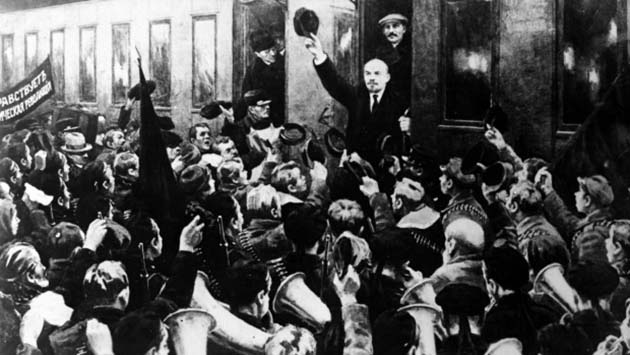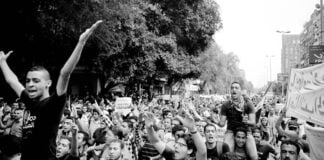Lenin’s April Theses argued that a second, socialist revolution was possible in Russia and re-oriented the Bolshevik Party to the fight for workers’ power explains Michael Douglas
One hundred years ago Russia was rocked by two revolutions in a single year. In February 1917 the bitterness felt by millions at the slaughter, poverty and profiteering brought by the First World War exploded in a mass revolutionary wave.
Starving workers rioted. Soldiers refused orders to shoot them. The Tsar, Nicolas Romanov, was forced from his throne and his Ministers arrested.
This complete political and economic disintegration forced millions of ordinary people to take the running of society into their own hands.
Democratic workers’ and soldiers councils—called Soviets—sprang up across the country. One eyewitness describes how, “It was clear to everyone that all effective workers’ organisations were at the disposal of the Soviet… It was for it to set in motion the immobilised railways, factories, the newspapers, and even to restore and safeguard the inhabitants from violence”.
In the midst of the general euphoria, Lenin returned to Russia from exile. He had behind him a quarter of a century of revolutionary activity—prison, exile, clandestine work and emigration, organising, educating and leading the Bolshevik Party. The president of the Petrograd (St Petersburg) Soviet, Chkheidza, greeted him at the Finland railway station in the name of the victorious Russian revolution, to the cheers of thousands of workers and soldiers.
Lenin shocked everyone, even his own party comrades, by immediately calling for a second revolution, “a thousand times more powerful than that of February”.
He presented a short written summary of his views the next day to a stunned Bolshevik Party conference. Published as the April Theses, this became one of the decisive documents of the revolution.
The April Theses marked a break with previous Bolshevik policy. Before February 1917, practically all Marxists believed socialist revolution was only possible in developed industrialised countries like Germany, France and Britain. Because economically backward Russia did not have the resources to provide for everyone’s needs, they said, fighting for socialism was premature.
The working class was still a small minority of society in a country dominated by peasants.
Both wings of the Russian socialist movement—Bolsheviks and the more conservative Mensheviks—considered Tsarist Russia a pre-capitalist society approaching a bourgeois capitalist revolution.
They expected this to free the country from Tsarism and transform it into a modern capitalist democracy, mirroring the experience of the French revolution of 1789.
Lenin and the Bolsheviks differed with the Mensheviks, however, in their insistence the revolution against Tsarism would be led by the working class rather than the capitalists, and on the need to build a revolutionary socialist party that fought for the political independence of the working class.
They agreed with the Mensheviks that only after a long process of capitalist development and transition through parliamentary democracy could the working class pose the question of socialism. History proved more complex.
Dual power
The February revolution combined elements of both a bourgeois and socialist revolution. The masses spontaneously arose, smashed Tsarism and gained effective control of the country through the Soviets. Yet the spontaneity of the revolution was also its weakness. The revolution was young, immature—it hated Tsarism and craved for unity against it. It trusted all the forces which claimed to stand for liberty and peace. So in its early days the Soviets were dominated by Mensheviks who believed power should pass to the capitalists rather than to the working class.
Within a few days of the February revolution, the Mensheviks called on the capitalists to take over the running of the country and form a Provisional Government.
The Provisional Government was dominated by the capitalists’ party, the Cadets. It refused to distribute the land to the peasants, offered little to the workers and vowed Russia would continue fighting the First World War “to the last drop of blood”. The Provisional Government lacked the means to enforce its will and relied on the Soviets, whose leaders took it upon themselves to subordinate the revolution to the capitalist class. Lenin explained that this was a situation of “dual power”.
“This dual power is evident in the existence of two governments: one is the… actual government of the bourgeoisie… which holds in its hands all the organs of state power; the other is… the Petrograd Soviet, which holds no organs of state power, but directly rests on the support of an obvious and indisputable majority of the people, on the armed workers and soldiers.”
Permanent revolution
Only the Russian socialist Leon Trotsky had foreseen such a possibility as early as 1905, drawing on the experience of the failed revolution that year. The solution he posed became known as the “theory of permanent revolution”.
Russian society was an example of what Trotsky called combined and uneven development. Late and sporadic industrialisation sponsored by the Tsars had produced a relatively weak capitalist class subordinate to the monarchy. But also a working class concentrated in heavy industry in several cities.
It was in these factories and districts that workers were to organise and wield the weapon of the mass strike, pioneered by the Chartist movement in England, putting it at the centre of a revolution for the first time.
The experience of 1905 showed that the capitalists hated and feared the workers movement from below more than the Tsarist state above.
In the face of revolution the capitalists sided with the autocracy, and through it with the landowners. They closed ranks and crushed the uprising.
Trotsky therefore believed the workers and peasants had to drive forward in opposition to the capitalists. A revolution led by the working class would not be limited to overthrowing the Tsar, but would grow over into a socialist revolution—and so become “permanent”.
“It would be the greatest utopianism to think that the [working class], having been raised to political domination by the internal mechanism of a bourgeois revolution can, even if it so desires, limit its mission to the creation of republican-democratic conditions for the social domination of the bourgeoisie,” he wrote. Workers would fight for their own interests such as better wages, working conditions and ultimately control of the factories.
Russia’s backwardness would be a problem, but this could be overcome provided the revolution linked itself to the international workers’ movement and the fight for socialism in the rest of Europe.
Now, in 1917, with the Provisional Government determined to continue the war, with the workers and soldiers struggling against it for their own interests, and with revolutionary attitudes developing throughout Europe, Lenin independently adopted a view identical to Trotsky’s.
Old Bolshevism
Lenin’s new position was that the Provisional Government had to be opposed, and that the Bolsheviks should aim to win workers and peasants to the slogan “All power to the Soviets”. “Only a proletarian republic,” said Lenin, “backed by the rural workers and the poorest sections of the peasants and town dwellers, can secure peace, provide bread, order and freedom.”
Lenin received no support from other Bolshevik leaders. Some charged him with treachery, lunacy, anarchy and more.
They still believed after February that the revolution should limit itself to the minimum program of a democratic republic, confiscation of landed estates, and an eight hour working day—the so-called “three pillars of Bolshevism”. Lenin had to repeat again and again, “We must abandon Old Bolshevism”, the previous party orthodoxy.
Lenin’s political opponents decided he was finished—so mad did his ideas sound, and so isolated was he within his own party. Yet it took him less than a month to win around a majority of the Bolsheviks. By the end of April he had won the debate at both a major Petrograd City Conference and at the Seventh All-Russian Congress of the party. Why?
Lenin’s reputation among party members and his skill in argument were important.
But even more powerful factors were at work. The Vyborg district of Petrograd, for example, had supported the transfer of power to the Soviets since the earliest days of the February revolution. Vyborg was the most advanced and militant working class district of Petrograd, where the biggest workplaces were located.
As time went on and disillusionment with the Provisional Government and the hardships produced by the war deepened, the radicalism of Vyborg spread. An early convert to Lenin’s position, Ludmilla Stal, remarked, “In accepting the slogans of Lenin, we are now doing what life itself suggests to us.”
Trotsky’s theory of permanent revolution allowed him to successfully chart the course of the 1917 revolution. But Trotsky was a brilliant general without an army to speak of, while Lenin was the recognised leader of a great party.
As an individual, Trotsky could make his words heard but only a massive and well-disciplined party like the Bolsheviks could transform words into action.
After joining the Bolsheviks, Trotsky wrote that his earlier failure to see the need for such a party had been, “the greatest mistake of my life.”
Once the Bolsheviks embraced Lenin’s April Theses they set out to win the majority of the working class, the poor and the soldiers to their side. Lenin was successful in April because he knew how to express the program of the revolution in a few clear and simple slogans which fitted the dynamic of the struggle, and meshed with the experience and needs of the masses.
He identified with the aspirations of the oppressed and had absolute confidence in the potential of the working class to shape society in its own interests. Six months later during the October revolution the working class proved him right.






